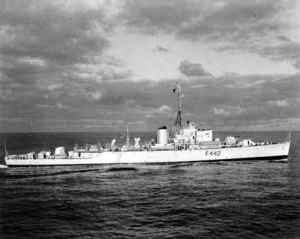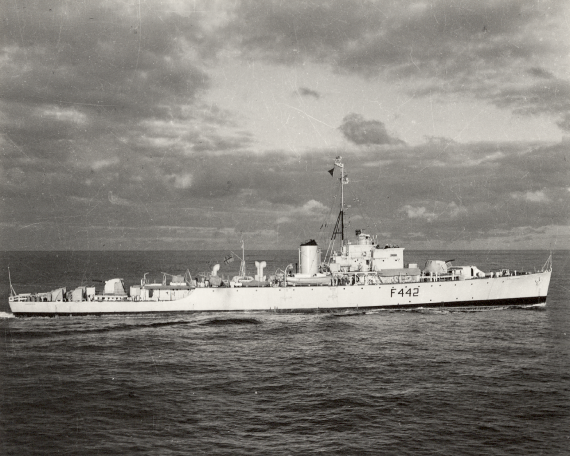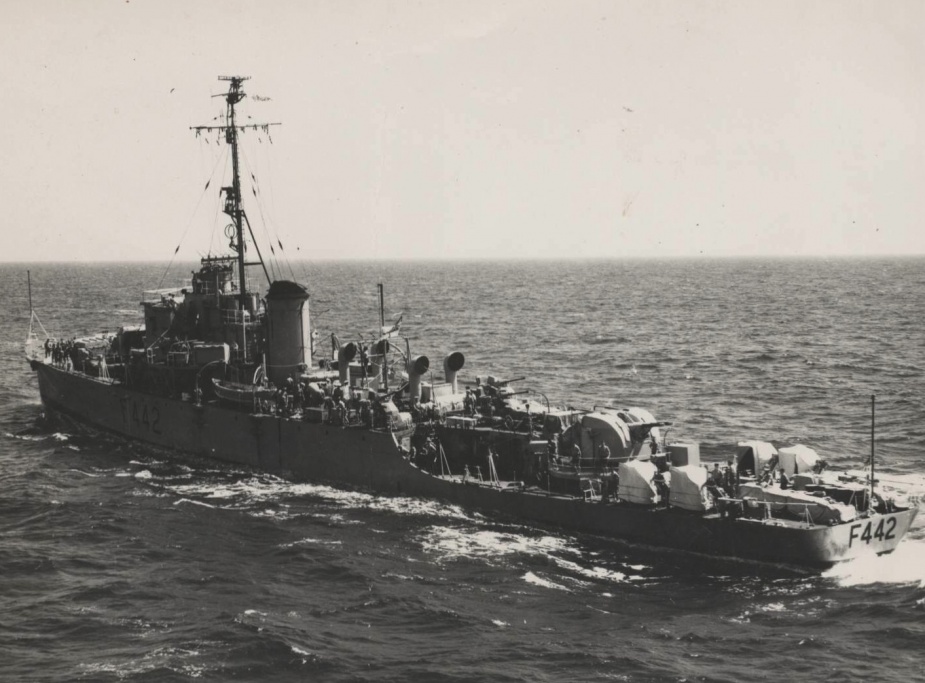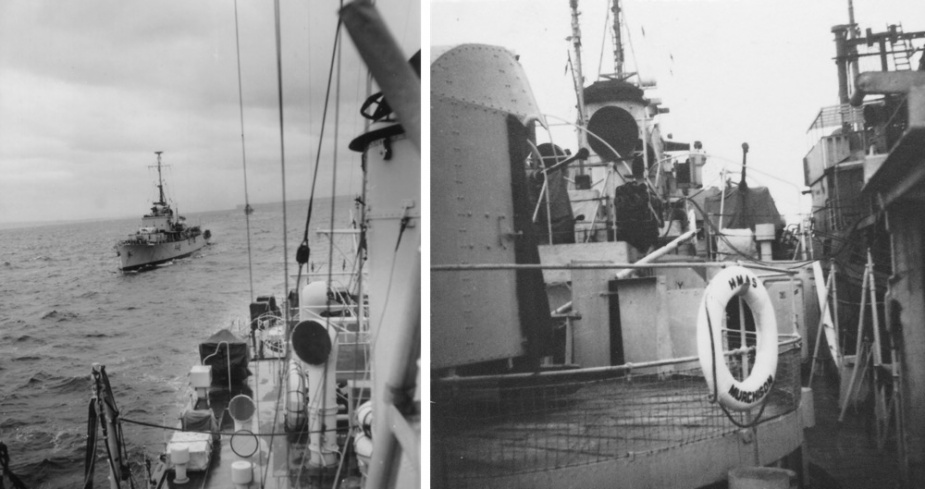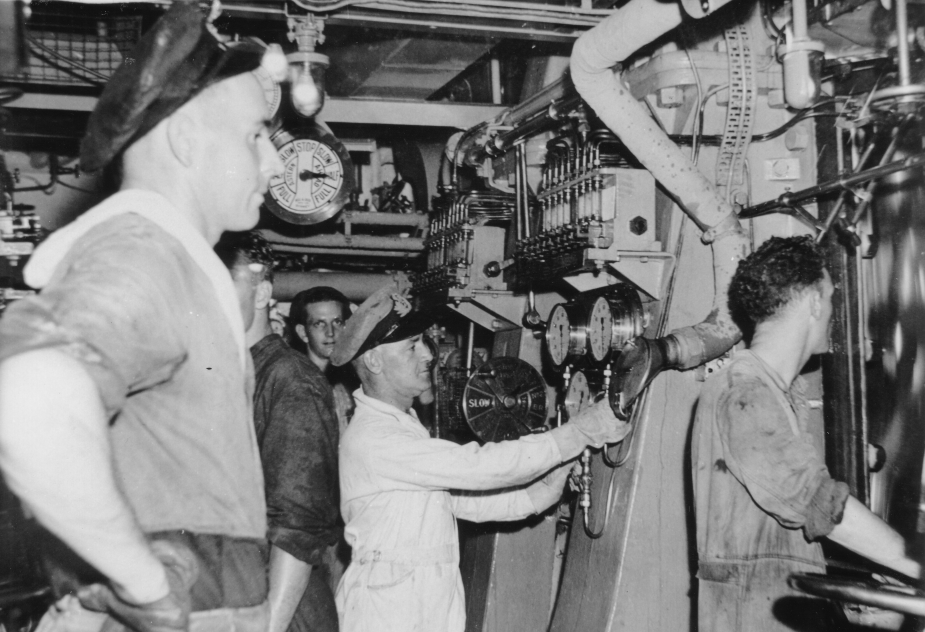HMAS Murchison
| Class |
Modified River (Bay) Class |
|---|---|
| Type |
Frigate |
| Pennant |
K442 |
| Builder |
Evans Deakin & Co Ltd, Brisbane |
| Laid Down |
3 June 1943 |
| Launched |
31 October 1944 |
| Launched by |
Mrs Courtice, wife of Senator B Courtice |
| Commissioned |
17 December 1945 |
| Decommissioned |
31 January 1956 |
| Dimensions & Displacement | |
| Displacement |
|
| Length | 301 feet 7 inches |
| Beam | 36 feet 6 inches |
| Draught | 12 feet |
| Performance | |
| Speed | 19.5 knots |
| Complement | |
| Crew | 175 |
| Propulsion | |
| Machinery | Triple expansion, 2 shafts |
| Horsepower | 5,500 |
| Armament | |
| Guns |
|
| Other Armament |
|
| Awards | |
| Battle Honours | KOREA 1950-53 |
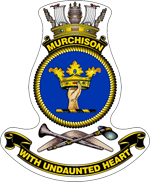
HMAS Murchison was ordered as part of Australia's shipbuilding program during the Second World War. Twelve of these Australian built frigates were to enter service with the Royal Australian Navy. A further ten were ordered but cancelled as the war drew to a close.
Eight, HMA Ships Barcoo, Barwon, Burdekin, Diamantina (I), Gascoyne (I), Hawkesbury (I), Lachlan and Macquarie, were built to the British River Class design and Australia likewise named its frigates after Australian rivers. A further four, HMA Ships Condamine (I), Culgoa, Murchison and Shoalhaven, were also named after Australian rivers but were built to the design of the Royal Navy's Bay Class Frigates. These latter ships were generally known as Modified River Class Frigates although they are sometimes referred to as Bay Class.
Murchison commissioned at Brisbane on 17 December 1945 under the command of Lieutenant Commander John McL Adams RAN.
After commissioning Murchison proceeded to Morotai, then Ternate and the Celebes on surveillance duties and for duty with the War Graves Commission. In February 1946 she proceeded to Japan for duty with the occupation forces, returning to Australia in May 1946.
From then until September 1948 Murchison was engaged on training duties mainly outside Sydney. In October 1948 she conducted a cruise to the New Hebrides, resuming training duties on her return to Australia. On 25 January 1950, when an explosion occurred in HMAS Tarakan (I), Murchison assisted in the rescue of several injured ratings.
In May 1951 Murchison proceeded to Japan for service in the Korean War. Operations began with two uneventful patrols off the Korean west coast in June 1951.
In July 1951 she joined the patrolling element, Task Element 95.12, operating off the mouth of the Yalu River and the approaches to Chinnampo. This phase of the patrol ended on 24 July with a successful bombardment of enemy tanks and vehicles south of Choda Island.
On 25 July, Murchison, HMS Cardigan Bay and the Korean Frigate PF62 initiated operations to probe the Han River to the limit of navigation as a demonstration of Allied control of the area. The patrol began with an abortive attempt to negotiate the uncharted waters of the Han River approaches on 25/26 July, followed by return to the assembly anchorage. Here the group was reinforced by HMS Morecambe Bay and six small craft of the South Korean Navy.
In the evening of 26 July the entire group, now designated Task Unit 95.12.2, proceeded and subsequently anchored without mishap in the chosen position, 37°48.7´N, 126°20.6´E, from which gunfire could be directed over a wide arc on the north shore of the Han River.
Murchison remained with this force bombarding shore installations, troop concentrations, gun emplacements and store dumps, until 4 August. Fire was maintained day and night with spotting planes from the west coast carrier element, Task Element 95.11, assisting by day. In eight successive days to the close of July, the Australian frigate expended some 1,100 rounds of 4-inch ammunition. Meanwhile survey parties from Murchison, operating in ship's boats, daily added their quota of soundings.
A brief visit to Sasebo was followed by escort duties to Inchon en route to rejoin the Han River bombardment group.
On 10 August Murchison rejoined Task Unit 95.12.2, now comprising Cardigan Bay, the South Korean PC62 and the Australian frigate. Murchison remained in the Han River area maintaining harassing fire and daily progressing the survey with ship's boats until 15 August, when she sailed to join HM Ships Ceylon and Kenya in the Mackau Island group.
The next seven days, from 17 to 24 August, were spent in avoiding a clash with an unpredictable typhoon named Marge. Murchison reached Kure on 24 August.
On 31 August Murchison rejoined the Han River unit and commencing the following day resumed the pattern of her two previous patrols. On 10 September she fired her parting quota of 50 rounds of 4-inch ammunition and left for Sasebo.
On 17 September Murchison began her fourth Han River patrol. The early days followed the usual pattern and were uneventful. On the twelfth day, 28 September, Murchison embarked the Commander Task Force 95, Rear Admiral G Dyer USN, for a tour of the Han River estuary. About 1600 the frigate was under way along the north bank of the Han River when unsuspected batteries of 75mm guns and 50mm mortars opened fire. Murchison responded with her 4-inch guns and with rapid short range fire, scoring several hits on the 75mm emplacements, silencing all opposition.
Two days later she returned to the scene of the engagement. The enemy, apparently expecting her return, had in the meantime strengthened their artillery. A second gun duel ensued, fought at such short range that Murchison's gunners were firing over open sights at a rate of 20 shells a minute.
Bolstered by their increased armament, the Communist forces maintained heavy concentrated fire and as the frigate endeavoured to manoeuvre in the fast tidal river channel, succeeded in holing the ship at several points above the waterline. However, Murchison's repeated hits took their toll on the enemy guns, reducing them to desultory fire, before the frigate withdrew to await reinforcement. Later joined by other ships of the patrol group she returned and with combined 4-inch shelling ended all opposition. Ammunition expenditure in this engagement totalled 276 rounds 4-inch and 500 rounds from the 40mm Bofors.
On 1 October, in company with HMNZS Rotoiti, a series of bombardments of enemy north bank positions with day long air strikes from USS Rendova adding their weight of explosive, at 1600 she fired her last shots of the patrol before proceeding for Kure for docking.
On 17 October Murchison returned to duty on the west coast, escorting the tanker Wave Chief en route to replenish the carrier element HMAS Sydney (III). This task was followed by a brief patrol of the Inchon approaches. On 21 October Murchison joined HMNS Hawea for a 24 hour patrol in the Yalu Gulf, followed by patrols off Chinnampo. On 22 October she succeeded in rescuing a ditched American airman, 1st Lieutenant F Biessner USAF, from dangerous mine fouled shallow waters. At times soundings showed less than one fathom under her keel and once she momentarily grounded. At dawn on 23 October, Sydney's aircraft guided the ship through the sandbanks to safe waters to join her relief, HMCS Cayuga.
In November 1951 Murchison returned to her old hunting ground on the Han River. Beginning with her usual task of escort to the fleet oiler on 1 November, she then relieved St Brides Bay as 'Sitting Duck' on the coast in the Sokto Island area. During this period, 3 to m November, she bombarded the enemy batteries on the Amgak Peninsula, landing spotting parties on Sokto Island to observe the fall of shot. On 5 November she was relieved by Athabaskan.
Between 6 and 16 November, Murchison operated in the Han River with Task Element 95.13, carrying out night harassing fire on suspected enemy gun emplacements and by day air spotted bombardments on targets reported by guerilla intelligence. Enemy activity was confined to anti-aircraft fire.
On 10 November she moved to the western position to bombard Yonan. Finally, on 16 November, after a quiet patrol she was relieved by HMS Whitesand Bay and departed for Kure.
On 27 November Murchison arrived at Paengyong Do from Sasebo en route to take up anti invasion duties protecting the islands of Taewha Do until the close of the month. On 30 November she resumed the role of 'Sitting Duck' in the Sokto/Chodo area until 3 December when she sailed for Inchon for escort duties to the Carrier Task Group, then to Sasebo and Hong Kong.
Murchison did not return to the west coast of Korea until 22 January 1952, when she joined HMS Belfast anchored off Techong Do and assumed the duty of Commander Task Unit 95.12.3, being the Han River Defence Unit.
On 24 January she returned to the familiar anchorage covering the north bank of the river where she remained for the next three days, maintaining day and night bombardments of the enemy positions.
Early on 28 January Murchison departed the Han estuary and proceeded to Techong Do to take over the defence of the island of Yuk To which was threatened by invasion. After two uneventful days the frigate returned to the Han River.
On arrival Murchison was handed a list of thirteen targets by local intelligence. In the ensuing bombardment, 'one hundred and fifty rounds of 4-inch ammunition was expended, over the thirteen targets. X guns crew achieved a peak of efficiency in this their swan song reaching a sustained rate of 21 rounds per gun per minute.' 'The Ship's Company of Murchison then took their farewell of the Han with various well chosen remarks.'
Murchison arrived in Sasebo on 2 February, bringing do a close eight months Korean War service. She returned to Sydney on 19 February 1952.
Following a refit she resumed duty as a training ship in June 1952, duties which continued until October 1953. In October 1952 Murchison was one of the ships detailed to patrol the Monte Bello Islands in support of the first British atomic test.
Although the Korean War ended in July 1953, patrols continued to be maintained in Korean waters. In October 1953 Murchison returned to the Far East for a series of post Armistice patrols off the Korean coast until July 1954 when she returned to Australia.
Murchison resumed duty as a training ship in November 1954 and continued in this role until she paid off into Reserve on 31 January 1956. Since commissioning the ship had steamed 175,712 miles.
Without being again brought into seagoing service, Murchison was sold for breaking up to the Tolo Mining & Smelting Co Ltd of Hong Kong on 21 September 1961. However the vessel was resold to the Japanese firm Amakasu Sangyo Kisen Co Ltd. She remained at a Navy mooring in Sydney Harbour until 7 September 1962. During that month Murchison and her sister ship Hawkesbury (I), also purchased by the same Japanese firm, were towed out of Sydney Harbour on their way to be scrapped.

